

In the early 19th century, Meriwether Lewis and William Clark led an ambitious expedition across the western United States. They greatly expanded our knowledge of the country’s geography and biological diversity through their specimen collection, mapping of the landscape, and detailed journal entries.
This year NASA and the National Park Service are encouraging the public to follow in the footsteps of Lewis and Clark through a new citizen science challenge. From June 1 to September 2, citizens are invited to use their smart phones and the NASA GLOBE Observer app to map land cover along the Lewis and Clark National Historic Trail to assist scientists studying environmental changes.
Land cover–such as grass, pavement, or trees–influences the water and energy cycles and influences a community’s vulnerability to natural disasters. NASA studies land cover changes from space as part of its mission to better understand our planet and improve lives.
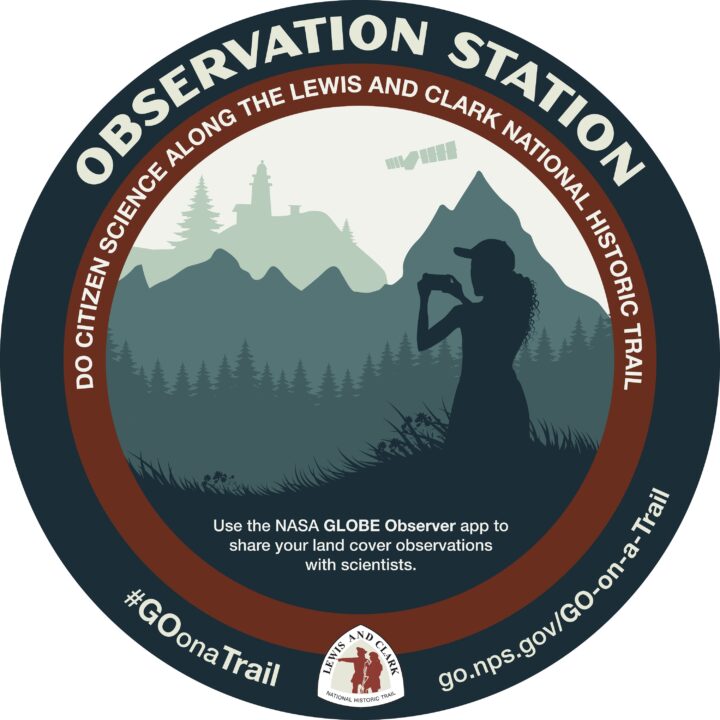
To participate in the “GO on a Trail” challenge, download the free GLOBE Observer app from the Apple App Store or Google Play. Use the Land Cover tool to make observations of the landscape. Any observation made along the 5,000-mile-long Lewis & Clark trail from Pittsburgh to the mouth of the Columbia River earns points. The top participants will receive recognition and GO on a Trail commemorative material.
A good place to get started is at an observation station marked with a large sticker (image above) at Lewis and Clark visitor centers and museums. To navigate to sites of interest along the trail, the Lewis and Clark National Historic Trail and GLOBE Observer teams have provided an online map.
“We hope that by becoming involved with this project, people will care about the trail and become its stewards,” said Dan Wiley, chief of integrated resource stewardship for the Lewis and Clark National Historic Trail. Wiley notes that the challenge will both spark a general interest in science and show the public how it can be involved in collecting vital information for decision makers.

GLOBE Observer is an app-based citizen science program active in more than 120 countries. The program invites citizens to contribute land cover, cloud, mosquito, and tree height observations to NASA and the science community. NASA-funded scientists are eager to see citizen science observations of land cover along this trail because of its wide range of ecological regions. Data collected during the challenge could help improve satellite-based mapping of land cover across the continent.
“We are observing and monitoring our changing home planet from space to better understand how it is changing and what are the main drivers of change,” said Eric Brown de Colstoun, a scientist at NASA Goddard Space Flight Center. “The view from the ground provided by the challenge participants is one component that helps us verify the space-based data.”
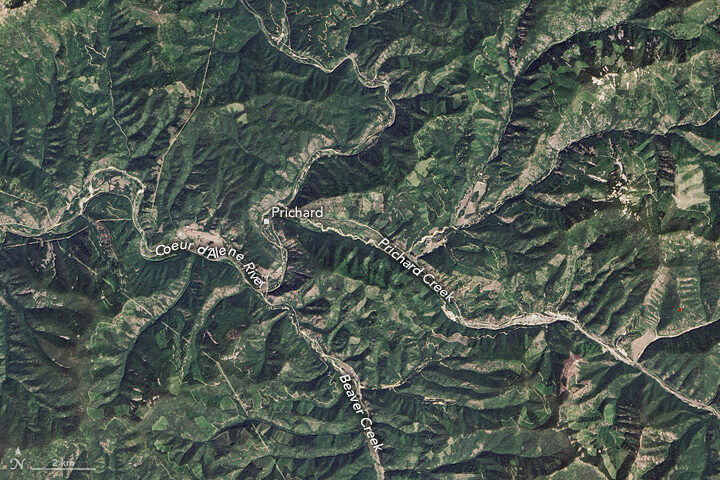
Even if you are not able to visit the Lewis and Clark Trail this summer, you can still join the GO on a Trail challenge from any of the more than 120 countries where GLOBE Observer is active. Just get outdoors and map the land cover around you. The top participants from beyond the trail will also receive recognition and commemorative material.
“Lewis and Clark and their team were exploring a totally new environment to them,” said Brown de Colstoun. “We invite you to get out and explore, and document the places you know and care about. Go on a trail and do science along with us.”
NASA GLOBE Observer and Lewis and Clark National Historic Trail will provide regular updates about the GO on a Trail challenge via social media throughout the summer with the hashtag #GOonaTrail. Follow GLOBE Observer on Facebook @nasa.globeobserver or Twitter @NASAGO. Follow the Lewis and Clark National Historic Trail on Facebook @lewisandclarknht, Twitter @lewisclarktrail, and Instagram @lewisandclarknht or visit the website at: https://www.nps.gov/lecl/index.htm.
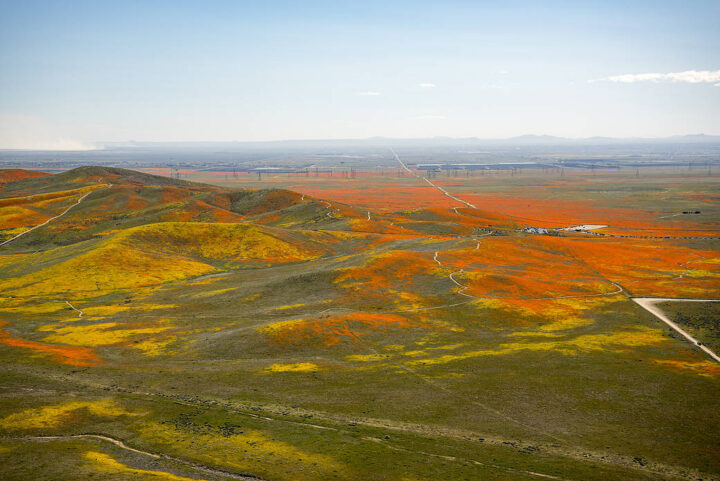
When we published a few Landsat images of wildflower super blooms in California in March 2019, you may have had to squint a little to find the flowers. From 705 kilometers (438 miles) above Earth’s surface, at the 15-meter-per-pixel resolution of the Operational Land Imager on Landsat 8, the flowers tend to blend with the hues of the desert.
Not so with this colorful photograph of poppies and other wildflowers in Antelope Valley that was taken from a T-34 airplane. The picture was shot by NASA Armstrong aerial photographer Jim Ross, who may have one of the coolest jobs at NASA. Watch the video below to find out how he got it.
Meanwhile, remote sensing scientist Iban Ameztoy was inspired enough by the aerial photos to pull Sentinel-2 satellite imagery of the same bloom and share them on Twitter.
Want more satellite imagery and aerial photography of the super bloom in California? NASA Earth Observatory and NASA Armstrong have you covered.
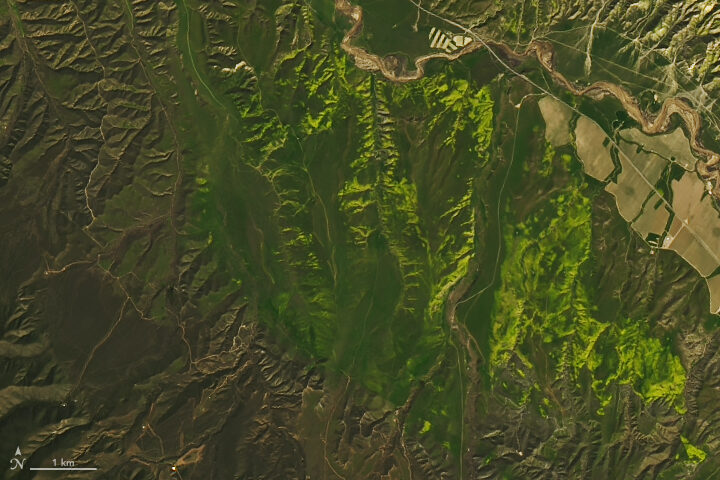
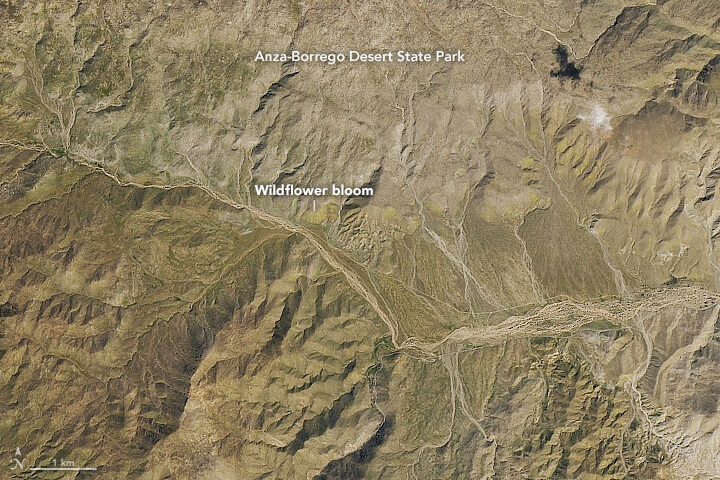
Join a mosquito mapping blitz for Citizen Science Day through GLOBE Observer.
Earth observations take place on many spatial scales. Some observations originate from sensors in space; others can happen with a mobile phone in the palm of your hand. GLOBE Observer is a free mobile app that connects an international network of citizen scientists with the broader scientific community in an effort to document and analyze changes taking place in Earth’s air, land, water, and life. The app is the centerpiece of a citizen science blitz now underway.
Both globalization and a changing climate have caused countless living creatures to adjust their range and distribution. For human health, one of the most concerning impacts of a changing climate is the range expansion of mosquitoes. These flying vectors of disease are responsible for illness in millions of people; they also cause more than 700,000 deaths each year.
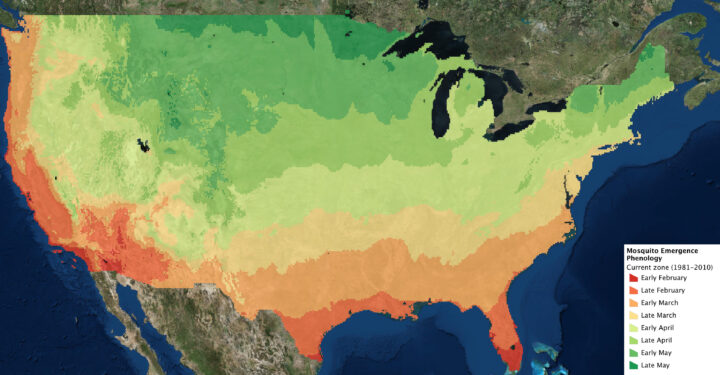
The northern hemisphere is now greening up in response to changes in sunlight and temperatures, and mosquito season is either just beginning or underway in much of the contiguous United States. The map above indicates when the first appearance of mosquitoes can be expected based on past weather data. The actual time of first appearance in a region can vary by several weeks, depending on the weather and other variables.
The GLOBE Observer app has a new tool known as the Mosquito Habitat Mapper, which makes it possible for citizen scientists to observe, record, and share data about mosquito breeding sites using a mobile phone. The data are important to scientists trying to predict disease outbreaks and epidemics. Observations provided by citizen scientists, combined with satellite observations and models, can make it possible to track the range and spread of invasive mosquitoes.
With the Mosquito Habitat Mapper, citizen scientists can report active and potential breeding sites in their communities. And using a built-in taxonomic key, GLOBE Observers can help determine whether the mosquito larvae have the potential to transmit disease pathogens to humans.
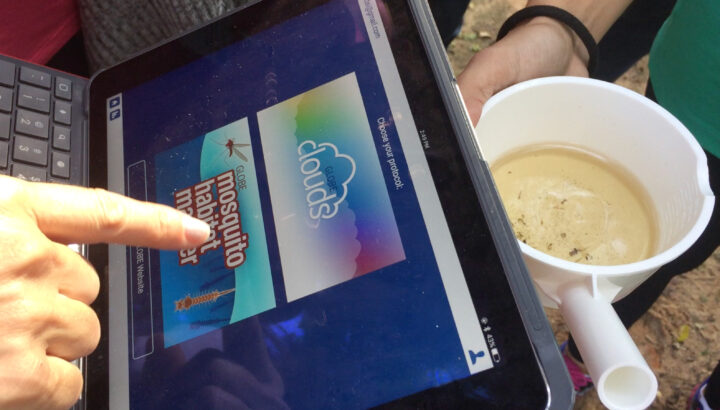
GLOBE Observers also can have an immediate impact on health in their community. In the last step of Mosquito Habitat Mapper, users report whether they were able to remove a breeding site. This can be accomplished in most cases by simply tipping and tossing standing water that is found in containers, or by covering stored water with a net or a lid. For larger water bodies such as ponds, irrigation ditches, or swamps, the reports about breeding sites can be used by mosquito surveillance agencies.
In this way, GLOBE Observers are not only engaged scientifically, they can become agents of change in their community. The World Health Organization (WHO) identifies source reduction–the elimination of mosquito breeding sites–as the most effective way to protect human populations and reduce the threat of mosquito vector-borne disease.
The GLOBE Observer Mosquito Blitz kicked off on April 7, 2019, and ends on Citizen Science Day (April 13). Join in this effort by downloading the app. Follow GLOBE Observer on social media during Mosquito Blitz week on Facebook or Twitter. Check out the Mosquito Blitz website and GLOBE Mission Mosquito for more mosquito resources.
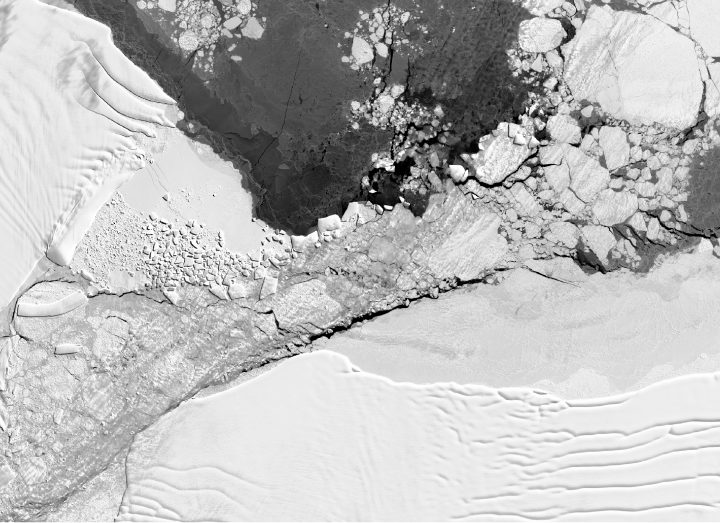
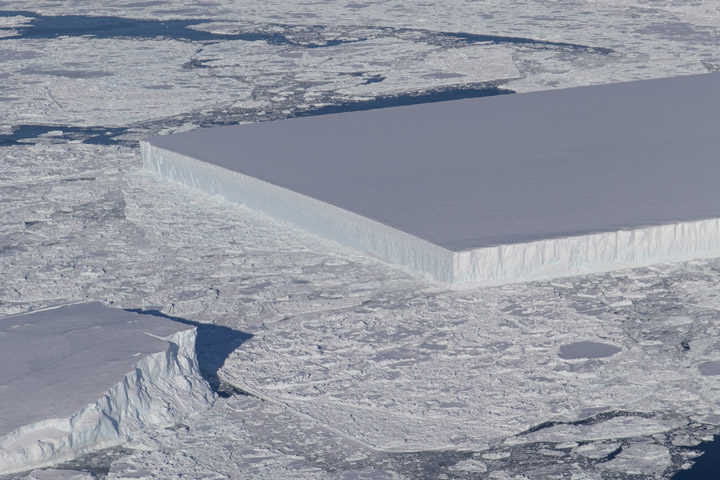
The sharp-angled iceberg that made headlines in late October 2018 had a longer, rougher journey than was initially thought.
The iceberg was spotted on October 16, 2018, during a flight for Operation IceBridge—NASA’s long-running aerial survey of polar ice. During that day’s survey of glaciers and ice shelves along the northern Antarctic Peninsula, scientist Jeremy Harbeck spotted the compelling berg. Harbeck explained in a NASA story his reason for taking the picture:
“I was actually more interested in capturing the A68 iceberg that we were about to fly over, but I thought this rectangular iceberg was visually interesting and fairly photogenic, so on a lark, I just took a couple photos.”
Not only were the edges of the iceberg extremely straight, but the two corners appeared “squared off” at right angles. The berg was so clean-cut that it was reasonable to assume it might have very recently calved from the Larsen C ice shelf. That’s the same ice shelf that spawned A-68, the trillion-ton iceberg that broke away in July 2017.
It turns out, however, that the rectangle berg actually has had a much longer journey. Scientists used images from Landsat 8 and the European Space Agency’s Sentinel-1 to trace the berg back to its origins. They found that it calved from the ice shelf’s new front in early November 2017, just a few months after A-68 broke away. The image below, tweeted November 9, 2018, by Stef Lhermitte of Delft University of Technology, shows the small, newly calved icebergs. The rectangle iceberg—which was about 4 kilometers long at the time—appears just north of a curved berg. Both were about a third of the way down the new front of the Larsen C.
The rectangle berg then began a northward journey, navigating the newly open water between the Larsen C ice shelf and Iceberg A-68. Collision threats were everywhere: A-68 could smash into the little bergs at any time, and smaller bergs could collide with each other.
The berg cruised all the way north and through a narrow passage between the A-68’s northern tip and a rocky outcrop near the ice shelf known as Bawden Ice Rise. NASA/UMBC glaciologist Chris Shuman likens this zone to a nutcracker. A-68 has repeatedly smashed against the rise and caused pieces of ice to splinter into clean-cut geometric shapes. An area of geometric ice rubble is visible in the Landsat 8 image (top and below) from October 14, 2018, two days before the IceBridge flight.
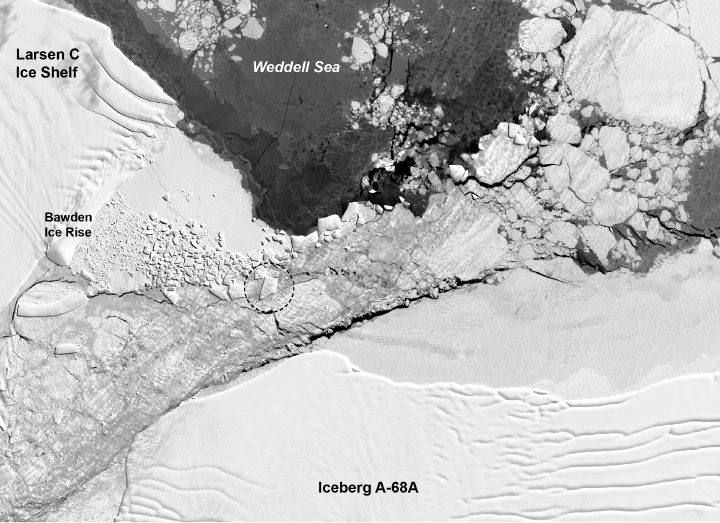
The once-long rectangle berg did not make it through unscathed; it broke into smaller bits. The iceberg in Harbeck’s photograph, circled in the annotated Landsat 8 satellite image, appears closer to the shape of a trapezoid. The trapezoidal berg is about 900 meters wide and 1500 meters long, which is tiny compared to the Delaware-sized A-68.
By November 2018 the iceberg had moved out of the rubble zone and into open water. Shuman noted: “Now it’s just another iceberg on its way to die.”
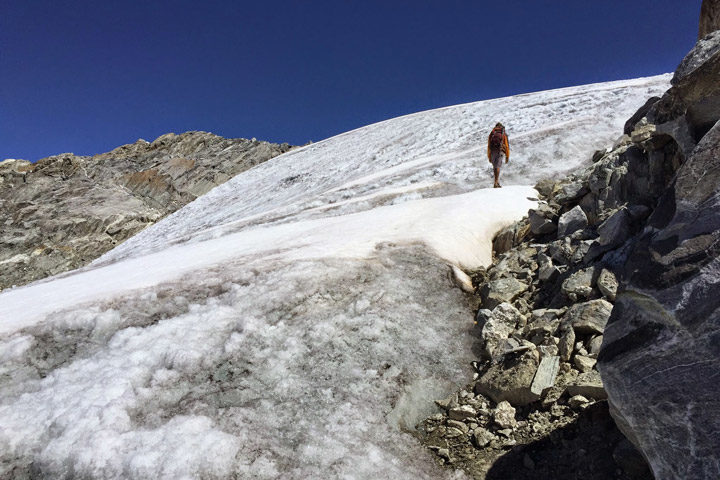
The retreat of Humboldt Glacier—Venezuela’s last patch of perennial ice—means that the country could soon be glacier-free. We featured the glacier in August 2018 as an Image of the Day showing how it changed between 1988 and 2015.
Satellite images can tell you a lot about a glacier, but direct measurements by people on the ground provide a unique, important perspective, especially for glaciers as small as Humboldt. Carsten Braun, a scientist at Westfield State University, last surveyed the glacier in 2015. He talked about what it was like to stand on Venezuela’s last glacier.
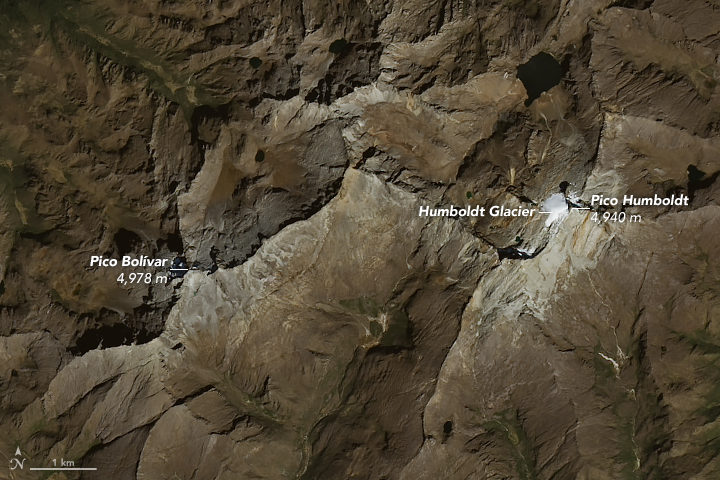
The Operational Land Imager (OLI) on Landsat 8 acquired this natural-color image of the glacier on January 6, 2015.
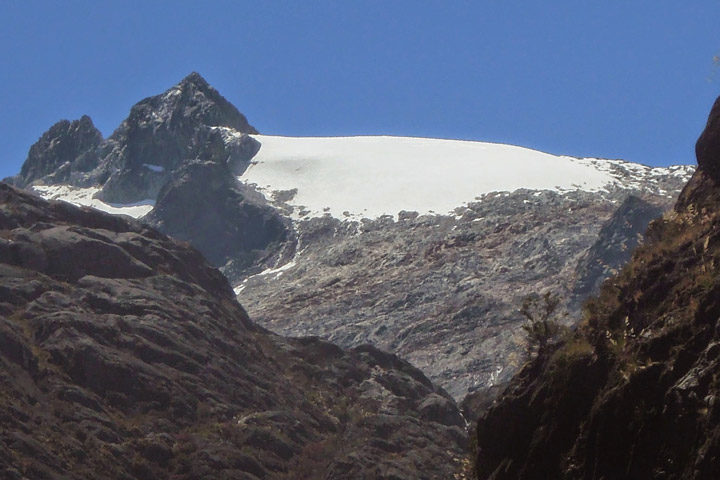
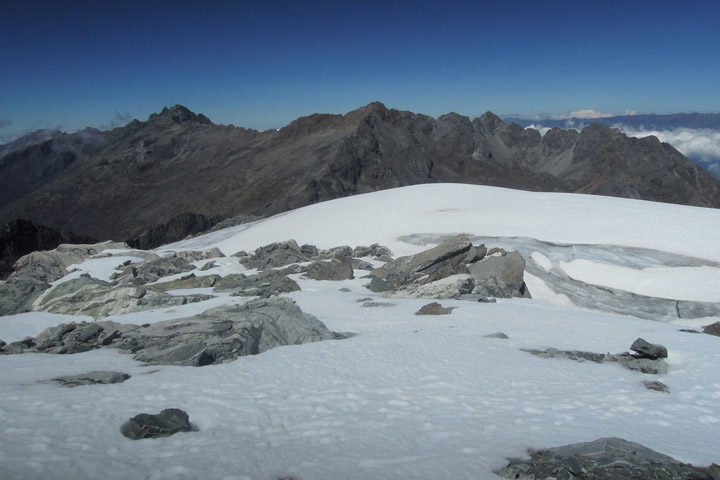
These photographs show the ground-based view of Humboldt Glacier in 2015. Photos by Carsten Braun.
What things were you measuring during the 2015 survey?
This was a very ‘low-tech’ trip: just me and a guide. The approach to the glacier takes two days of very rough hiking with big packs. That gets you to base camp at Laguna Verde below the glacier.
To get to the glacier takes another three hours on rough terrain. This is definitely popular with climbers. They cross the Humboldt Glacier and then summit Pico Humboldt.
I did the same thing in 2009 and 2011: I walked around the glacier right on the margin with a simple GPS receiver to make a map of it. That sounds a lot easier than it is. Walking right on the edge of a glacier can be difficult and dangerous. This was definitely both!
What was the ice like? Parts of it look like snow or slush.
This glacier is little different than what you may have experienced. It is tiny and does not have an accumulation area. The surface is 100 percent ice everywhere, just covered in some parts in wet seasonal snow that will melt away. Basically that means that the Humboldt Glacier has no means to ‘add’ mass (‘eat’) and continuously loses mass everywhere (‘fasting’). Obviously, that’s not sustainable.
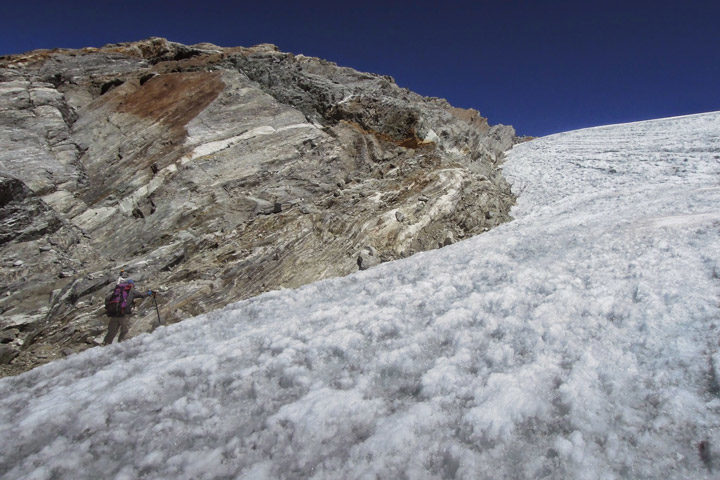
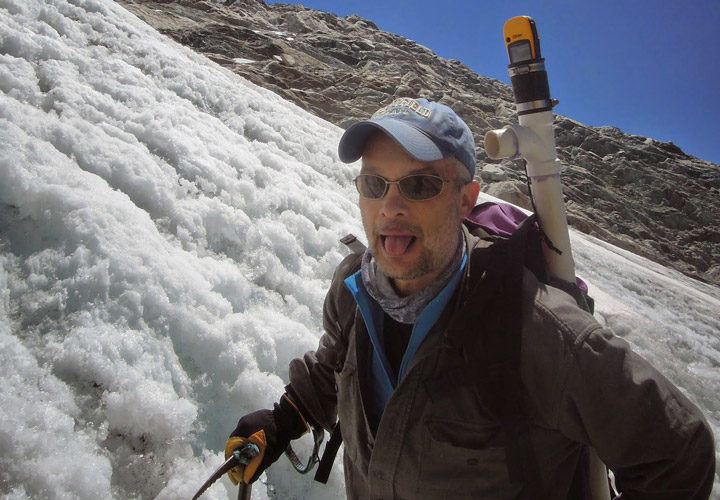
Photos by Carsten Braun.
Do you remember what you were thinking while hiking on the country’s last glacier?
I was definitely considering the impacts of losing this glacier. It has little ‘practical use’ today, as it is so small and pretty much irrelevant for water supply. Its disappearance would not impact water resources much, if at all. That’s much in contrast with countries like Peru and Bolivia, where glacier recession already creates huge problems for water resources, hydro-power, etc.
The impact in Venezuela is more at a spiritual level. The mountain chain is was named Sierra Nevada de Mérida (snowy mountain range of Mérida) because of its glacier cover. Now it will be gone soon and may never come back again. (Well, that’s up to us humans to decide.) And with that, the reality of these mountains will change. The lack of glaciers will be the ‘new normal.’ It’s a little bit like losing a species: once it’s gone, you never realize that it is missing.
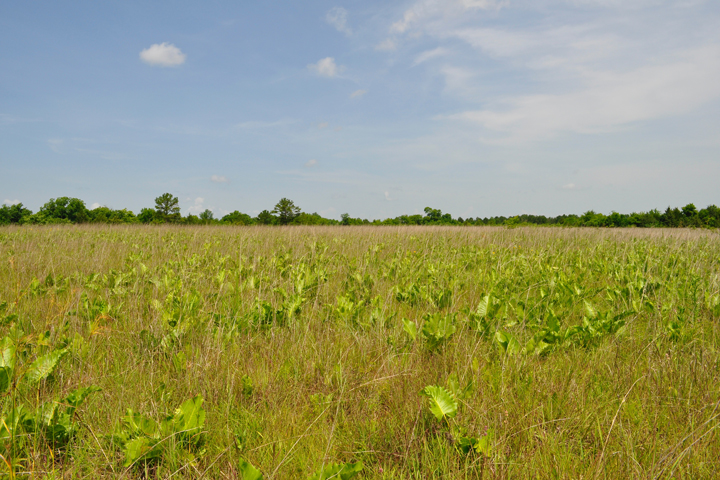
Photo by JoVonn Hill, Mississippi State University.

NASA Earth Observatory images by Joshua Stevens.
This month we published a satellite image and map of the southern United States featuring the Black Belt Prairie—a crescent-shaped swath of land running through Mississippi and Alabama named for its characteristically dark, fertile soil. Most of the fertile soils are cultivated, contrasting sharply with adjacent forested areas.
Grassland expert JoVonn Hill of Mississippi State University noted that in the 1830s, the Black Belt contained about 356,000 acres of prairie. Today, less than 1 percent of prairie land remains. One such prairie remnant is the Pulliam Prairie in Chickasaw County, Mississippi. Hill snapped this photograph (top image) of native grassland within the Pulliam Prairie, which in total spans about 250 acres. That’s a decent size for Black Belt prairie remnants, most of which span just 5-20 acres.
Pulliam Prairie is one of the most significant prairie remnants in Mississippi, given its large area and the diversity of species found there. Black Belt prairie remnants dot the landscape in Alabama too, all of which are important sites for the supporting an array of native vegetation and habitat. As Hill noted in our initial story about the region: “Find a remnant of the Black Belt prairie, and you could see some of its unique grassland birds; more than 200 species of plants, 1,000 species of moths, 107 species of bees, 33 species of grasshoppers, and 53 species of ants.”
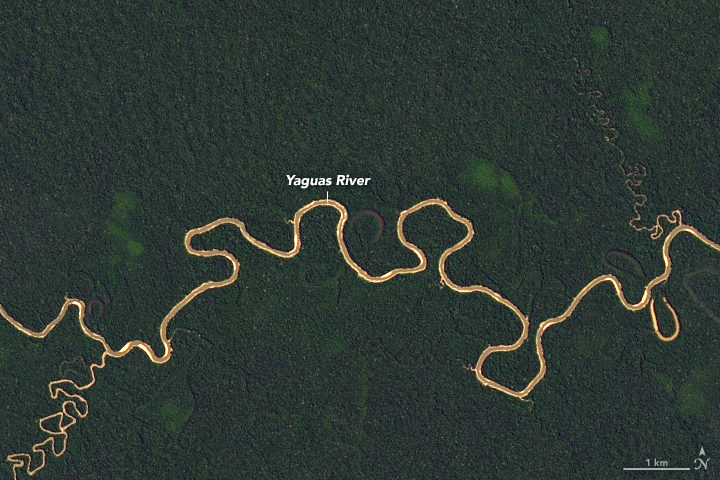
In January 2018, Peru’s protected area grew by more than 2 million acres with the creation of Yaguas National Park. The forest is largely intact, unbroken by roads and human activity. Only the Yaguas River cuts through the continuous canopy, visible in this image acquired by Landsat 8 in August 2017.
Scientists from the Field Museum got an even closer look at the forest when they flew over it before it was designated a national park. “When you see it from the air, it appears to stretch to the horizon,” said Corine Vriesendorp, a conservation ecologist at the Field, in a story about the new park. The following photographs by Álvaro del Campo offer this aerial perspective.
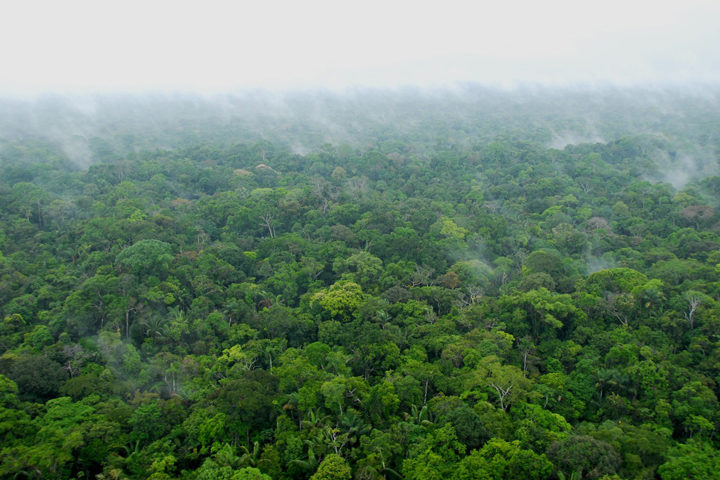
The first photo shows an area of intact forest inside Yaguas National Park. Expanses like this one are important for the diversity of the region’s plants and animals.
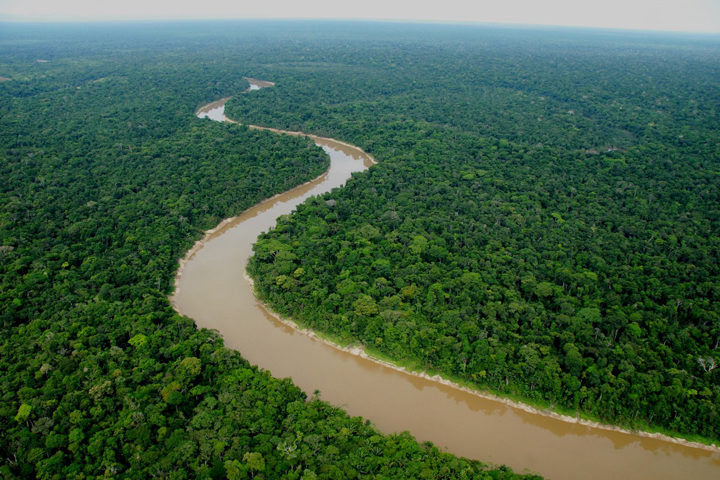
The park preserves more than forest; it protects an entire watershed. A segment of the Yaguas River is visible in the the second photograph. According to an inventory conducted by the Field Museum in 2010, the diversity of fish in this river could be the highest in Peru. Over the span of three weeks, experts counted 337 species of fish.
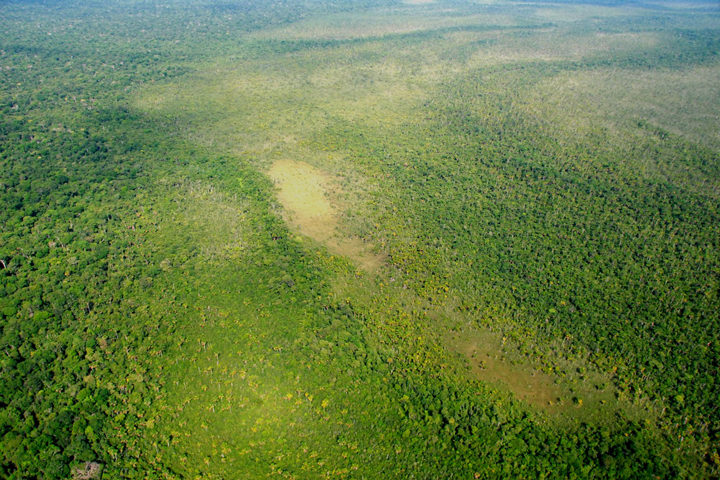
In the satellite image at the top of this page, notice the yellow areas on either side of the river that appear to be bare. These are actually peatlands: grounds rich with a soil-like mixture of partly decayed plant material that can build up in the abandoned river meanders. The photograph above provides an aerial view of peatlands.
“Ten years ago, we were just beginning to realize that there were important peat deposits in the Peruvian Amazon,” Vriesendorp said in a March 2018 Image of the Day. “Although there has been no comprehensive mapping of the Putumayo’s peatlands to date, it is likely that the below-ground carbon stock is immense.”
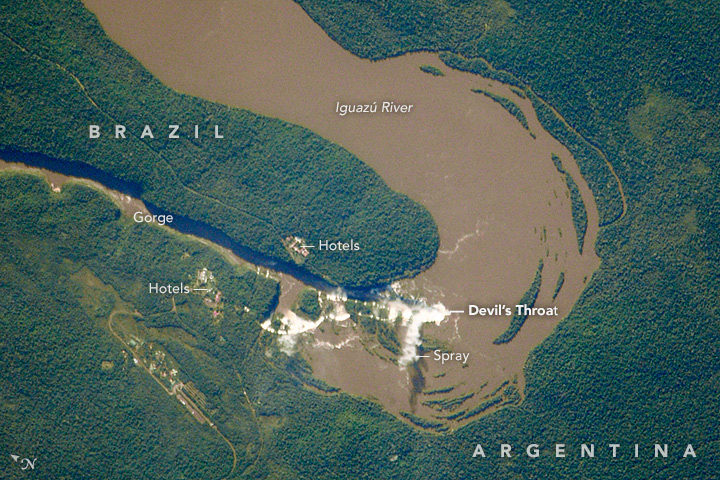
In 2016, we published space-based imagery of Iguazú Falls—South America’s famous system of waterfalls, which is near a bend in the Iguazú River between Argentina and Brazil. Spray from the falls reaches so high that it is visible from space. A crew member aboard the International Space Station captured the photograph above on May 24, 2016.
The view from the ground is also quite compelling, attracting more than a million visitors per year. The images below show ground-based views of the falls, photographed photographed by NASA’s Alexey Chibisov from the Argentine side of the river on November 28, 2017. Chibisov took the photos while on vacation after weeks in the field with the Operation IceBridge mission.
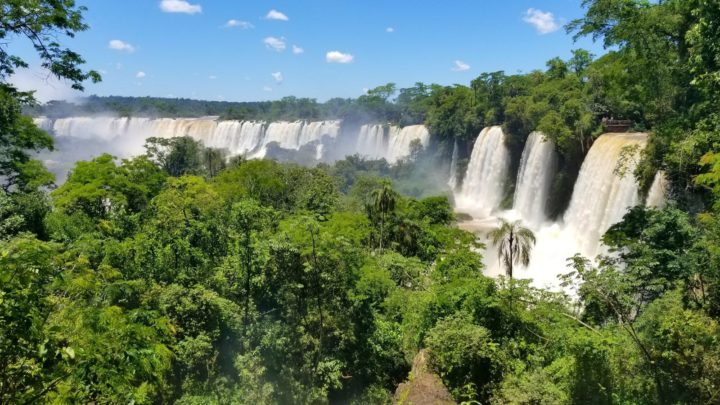
Photo by Alexey Chibisov.
Lush, subtropical rainforest surrounds the falls. The vegetation here is part of a remaining fragment of the Atlantic Forest, which stretches from the east coast of South America inland toward the Amazon. The forest is habitat for tens of thousands of plant species and thousands of animal species.
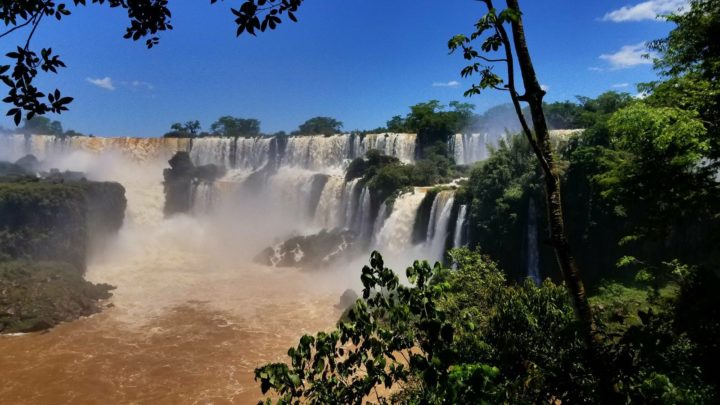
Photo by Alexey Chibisov.
Sediment carried by the fast-moving river can impart a red-brown color to the water, especially after periods of heavy rain.

Photo by Alexey Chibisov.
The mist is the result of water that plunges as much as 260 feet (80 meters) over layers of basalt cliffs.
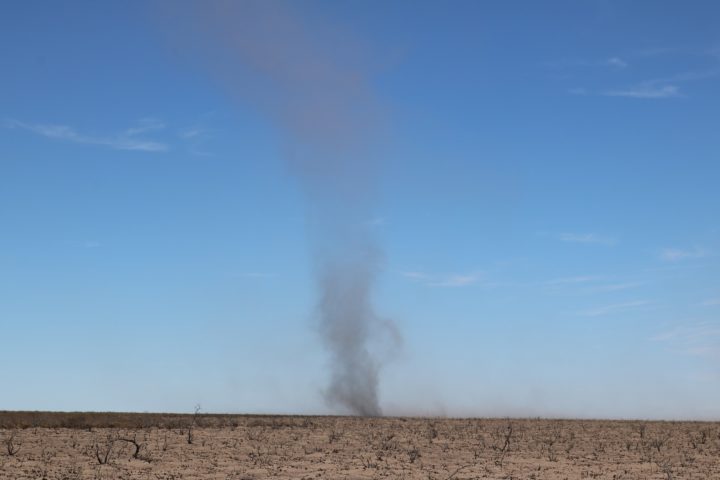
Photo courtesy of Luciano Javier Avila.
Dozens of wildfires blazed along the Atlantic coast of Argentina coast last winter. One of them left behind a massive burn scar near the Valdez Peninsula. When we wrote about the fires last month, we were unable to say with certainty whether the plume rising off the burn scar was airborne ash or dust. A quick recap from our article:
This part of Argentina’s coast is sparsely populated, arid, and covered in scrubby undergrowth. The closest city is Puerto Madryn, more than 30 kilometers (20 miles) from the burn scar. Due to this remoteness, it is difficult to verify the composition of plumes.
At the time, Santiago Gassó, a NASA scientist who studies the global transport of ash and dust, gave us his best guess:
While Gassó believes ash caused this plume, it is possible that finely ground rock and soil dust also could have become dislodged by the fire. Vegetation and roots (which usually hold the soil in place) would have been removed by the fire, making it easier for the strong regional winds to sweep dust off of the land.
Since then, a reader has written to us with more details. Luciano Javier Avila, a biologist with the Patagonian Institute for the Study of Continental Ecosystems, walked around the site just days after the fires and took photos of the burned area. He confirmed that the cloud was, in fact, dust. Strong winds in January and February caused dust plumes visible from Madryn.
The fire highlights the importance of plants in this semi-arid region, according to Avila. Many of the plants which used to grow here are larrea (“jarilla” in Spanish), a desert shrub that flowers in yellow. Without their roots holding the soil together, the wind was able to blow large amounts of fine dust into the air.
Watch out, master gardeners: There’s competition up above.
Scientists have made marked developments in growing vegetables in space this spring. Researchers based at Kennedy Space Center have been working with a team from the University of Arizona to create a prototype lunar/Mars greenhouse. The cylindrical, inflatable chamber measures 18 feet long and 8 feet in diameter. It recycles waste and water from astronauts, and uses carbon dioxide they exhale.
Growing edible plants in space will allow humans to venture farther beyond our home planet, said Ray Wheeler, lead scientist for Kennedy Advanced Life Support Research. “The greenhouses provide a more autonomous approach to long-term exploration on the Moon, Mars and beyond,” he said.
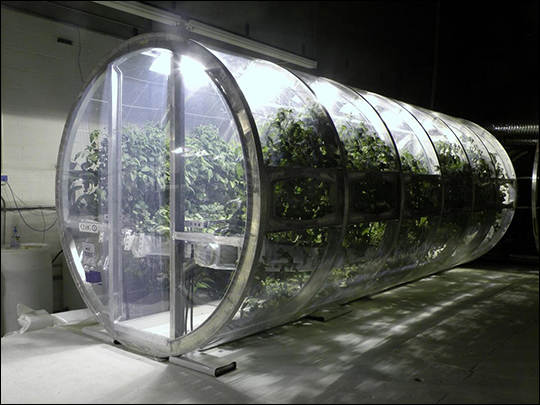
Image by University of Arizona.
In other space veggie tales…
Last month, perhaps the most-watched cabbage in the world—technically speaking, in Earth orbit—sprouted. Two tiny shoots of the Tokyo Bekana Chinese cabbage poked out of their specially-designed plant pillow. The pillow acts like a miniature plant bed, providing nutrients without the mess of dirt careening through space.
The cabbage is but the most recent crop on the ISS. The crew’s first harvest of space veggies from the Veg-01 experiment took place in 2015. However, flower-raising efforts have encountered a few more obstacles, including the formation of mold.
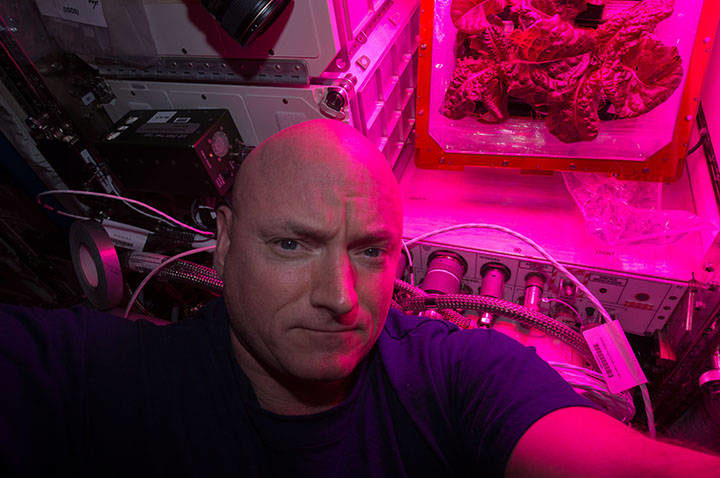
Scott Kelly with romaine lettuce. Image by NASA.
To learn more, check out this video, aptly titled “Lettuce Look at Veggie”: